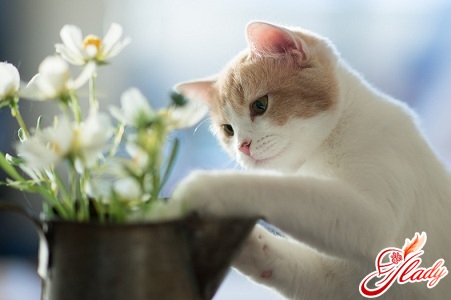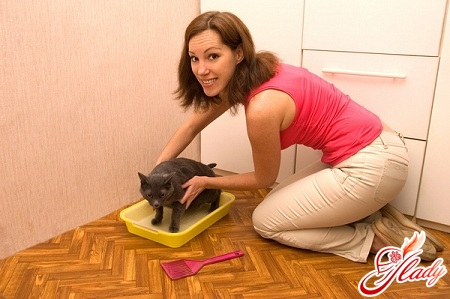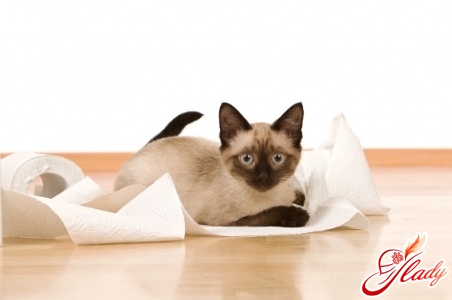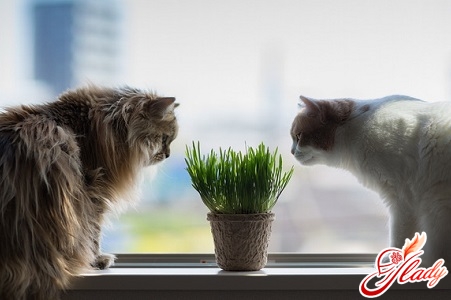 Cats are wayward creatures.And let's be honest, they have a strong character. Despite their natural intelligence and quick wits, these animals often suffer because of their own stubbornness and unwillingness to put up with the rules set by humans. For example, they ignore the litter box prepared for the toilet and stubbornly relieve themselves in the place they choose themselves. Most cat owners do not have this problem when the animal has lived in the house practically since infancy, and at the same age it was trained to use the litter box (kittens are generally easy to train to use the litter box). If an adult cat that was previously trained to use the litter box is settling in your house, then most likely it will quickly figure out where its toilet is in the new house and will use it regularly. However, this may not happen if the change of residence causes real stress for the animal, and the refusal to use the litter box becomes a kind of protest. An adult cat taken from the street or simply accustomed to going to the toilet in the open air, and not in a plastic tray, will also have to be trained to use a litter box. Therefore, the question of how to do this is far from idle. For many, a cat's refusal to use a litter box becomes a stumbling block in relations with the animal. As a result of an unsuccessful struggle for a person, such stubborn cats at best move to live in the private sector, and at worst end up on the street. We will not discuss the moral side of such behavior of the owners of stubborn cats, but talk about how to try to train an adult cat to use a litter box.
Cats are wayward creatures.And let's be honest, they have a strong character. Despite their natural intelligence and quick wits, these animals often suffer because of their own stubbornness and unwillingness to put up with the rules set by humans. For example, they ignore the litter box prepared for the toilet and stubbornly relieve themselves in the place they choose themselves. Most cat owners do not have this problem when the animal has lived in the house practically since infancy, and at the same age it was trained to use the litter box (kittens are generally easy to train to use the litter box). If an adult cat that was previously trained to use the litter box is settling in your house, then most likely it will quickly figure out where its toilet is in the new house and will use it regularly. However, this may not happen if the change of residence causes real stress for the animal, and the refusal to use the litter box becomes a kind of protest. An adult cat taken from the street or simply accustomed to going to the toilet in the open air, and not in a plastic tray, will also have to be trained to use a litter box. Therefore, the question of how to do this is far from idle. For many, a cat's refusal to use a litter box becomes a stumbling block in relations with the animal. As a result of an unsuccessful struggle for a person, such stubborn cats at best move to live in the private sector, and at worst end up on the street. We will not discuss the moral side of such behavior of the owners of stubborn cats, but talk about how to try to train an adult cat to use a litter box.
Choose a place for the toilet
Cats are delicate creatures.As a latrine, they choose secluded corners, hidden from prying eyes. Therefore, you need to choose such a place for the litter box in the house. The most suitable place to place a cat litter box in an apartment will be a bathroom or toilet, as well as a balcony (loggia), if it is insulated. In addition, do not forget that the animal should be able to freely approach its toilet at any time. This will allow you to train your cat or cat to a new toilet faster and easier. The kitchen and hallway are categorically not suitable for a cat litter box. Firstly, this is unacceptable from the point of view of apartment hygiene. Agree that a toilet (even a cat's) has no place in the kitchen, where food is prepared, or in the hallway, where people dress and put on shoes. A conditionally suitable place can be considered a pantry, if it is convenient for you and your cat. Secondly, a cat may refuse to use the toilet where people are often: it, as already mentioned, is a delicate creature.
Select the tray
If an adult cat before settling inyour home, did not know what a tray is, then she should like it: be spacious and comfortable enough for her to recognize it as a toilet. What does a comfortable tray mean? First of all, deep: after all, it is intended for an adult animal. The depth of the tray should not be less than ten centimeters. This will allow the cat to dig in it to prepare a place for the intimate process, and then hide its results. In addition, the high sides of the tray will not allow the filler to spill out onto the floor. And the width and length of the tray should be sufficient for the animal to fit completely in it. An alternative to a tray-cuvette will be a special toilet house, which will be comfortable for the cat and will make it easier for you to care for the cat's toilet. The fact is that such special houses are equipped with filters that clean the air from the natural smell of what remains in it after the cat's visit. And if you do not have time to clean the tray in time, the filters will neutralize the smell. Cats also start to go to the toilet with great pleasure, using houses, since such toilets are equipped with a roof and walls and completely hide the cat from prying eyes. And you can place such a closed toilet not only in the bathroom, but even in the hallway - this will not embarrass the cat.
Accustoming the cat to the toilet
Very often animals intuitively understand,what the tray prepared for them is intended for. And yet, you will have to make some effort to train an adult cat to a new toilet. By the way, the common opinion that it is easier to train a female cat to a tray than a male cat is wrong. Yes, of course, a male cat is driven by male instincts, according to which he must mark the territory in a certain way. Therefore, very often in a new environment, the animal begins to leave marks. But a female cat is more capricious. And if she does not like the place, she will stubbornly refuse to go to the tray and will choose a place for the toilet herself. But let's start in order. First, you need to keep an eye on the animal. The cat will want to relieve itself soon after the meal. Although, note that they can endure for a long time. By the way, you can introduce the cat to the toilet immediately after its appearance in the house. As we have already said, animals often intuitively understand the purpose of the tray. If this is what happened in your case, then the problem is solved: having gone to the tray once, the cat (or male cat) will begin to use it constantly. But if the animal does not immediately recognize the tray as its toilet, then wait until the need arises. Having wanted to go to the toilet, the cat will start looking for a secluded place to relieve itself. Having noticed this, pick up the animal, take it to the tray and put it in it. Stroke, calm it down and move away. Most likely, the cat will start digging the filler, settle down and eventually do its business in the tray. If it jumps out of the tray and tries to run away, return it to the tray again and again until it relieves itself there. Another option. Having seen that the cat has chosen a place and is already settling down to pee or poop, quickly put the tray on this place and put the animal in it. Being almost in the process, the animal will continue the business, finding itself in the tray. Do not change the filler: the next time the cat will start looking for the toilet by smell. If it again goes to the same place, then take it to the tray. Having smelled a familiar odor, the cat will use the tray for its intended purpose. If the animal still returns to the same place, put the tray there for a while and start gradually moving it to where you originally intended to place the tray. This will take time, but the animal will not notice this process of moving. And one more piece of advice. If you took a cat from the street, then at first, pour regular soil or sand into the tray instead of filler: the familiar consistency and smell of what is in the tray will help the cat understand what the tray is intended for. If the animal has made a mess in a secluded corner in your absence, blot the puddle with a napkin and put this napkin in the tray. If, in addition to the puddle, the animal has left behind more visible traces, then also transfer these “traces” to the tray. And generously treat the place chosen by the cat for the toilet with ammonia or vinegar essence: a strong and pungent smell will force the animal to ignore this place.
Possible problems
Sometimes you have to force them to use the litter boxis an adult cat who, up until a certain point, willingly used it. Before scolding the animal, consult a veterinarian: such behavior may be an alarming signal and indicate health problems with the animal. Such behavior of an adult cat may also indicate an inconvenient litter box or an inappropriate place for the toilet. Let the cat choose the place for the litter box itself and arrange the toilet there. Cats may also be disgusted by a dirty litter box. Some animals meow demandingly, drawing your attention to this problem, while others ignore the dirty litter box silently, simply finding a new place to go to the toilet. Many cats do not want to use the same litter box with another animal. And if you have more than one cat in your house, then buy a separate litter box for each animal. In general, it is impossible to say exactly how easy it will be for you to train a cat to use the toilet. Everything depends on the character, temperament and intelligence of the animal. But nothing is impossible. With enough patience on your part, sooner or later the cat will recognize the litter box as a toilet and start going there. Be persistent and inventive, and you will definitely succeed! We recommend reading:









